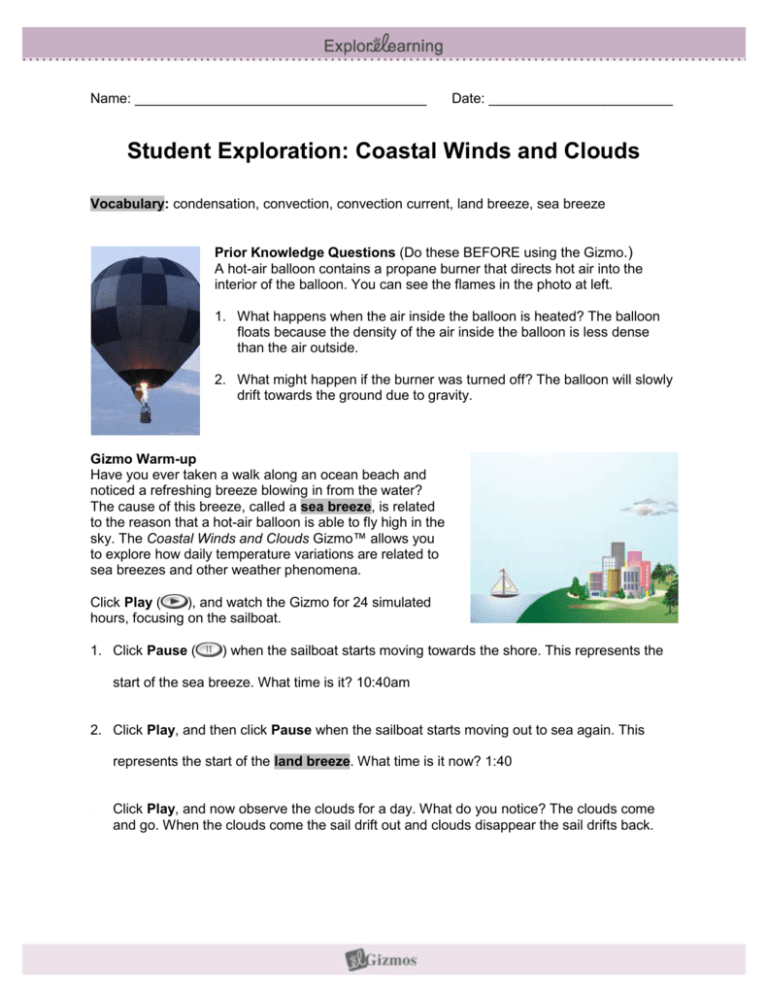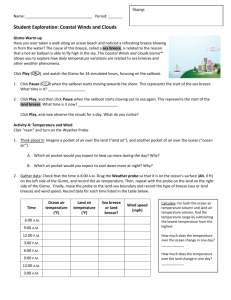EL-Student-Guide-Coastal
advertisement

Name: ______________________________________ Date: ________________________ Student Exploration: Coastal Winds and Clouds Vocabulary: condensation, convection, convection current, land breeze, sea breeze Prior Knowledge Questions (Do these BEFORE using the Gizmo.) A hot-air balloon contains a propane burner that directs hot air into the interior of the balloon. You can see the flames in the photo at left. 1. What happens when the air inside the balloon is heated? The balloon floats because the density of the air inside the balloon is less dense than the air outside. 2. What might happen if the burner was turned off? The balloon will slowly drift towards the ground due to gravity. Gizmo Warm-up Have you ever taken a walk along an ocean beach and noticed a refreshing breeze blowing in from the water? The cause of this breeze, called a sea breeze, is related to the reason that a hot-air balloon is able to fly high in the sky. The Coastal Winds and Clouds Gizmo™ allows you to explore how daily temperature variations are related to sea breezes and other weather phenomena. Click Play ( ), and watch the Gizmo for 24 simulated hours, focusing on the sailboat. 1. Click Pause ( ) when the sailboat starts moving towards the shore. This represents the start of the sea breeze. What time is it? 10:40am 2. Click Play, and then click Pause when the sailboat starts moving out to sea again. This represents the start of the land breeze. What time is it now? 1:40 3. Click Play, and now observe the clouds for a day. What do you notice? The clouds come and go. When the clouds come the sail drift out and clouds disappear the sail drifts back. Activity B: Convection currents Get the Gizmo ready: Click Reset. Turn on the Drifting balloon. Question: Why do land breezes and sea breezes occur? 1. Observe: Click Play, and observe the balloon for a period of 48 hours. Pause the simulation whenever the balloon changes direction. Describe what you see in the space below. 2. Analyze: During what time period does the balloon drift in a clockwise direction? Afternoon 3. During what time period does the balloon drift in a counterclockwise direction? __________ _________________________________________________________________________ 4. Gather data: The diagram at right shows the scene at 6:00 A.M. Use the Weather probe to find and label the temperature at each of the numbered locations. Next, find the wind direction between the points on the diagram. Draw arrows to represent the movement of air. Which points represent the lowest and highest temperatures on the diagram? Lowest: Highest: _________ 5. Analyze: In which direction is the hottest air in the diagram moving? ___________________ In which direction is the coldest air in the diagram moving? ___________________ This pattern—in which low-density, hot air rises while high-density, cold air sinks—is an example of convection. The resulting circular flow of air is called a convection current.











